INTRODUCTION
Rice is the main staple food for approximately 70 percent of the world’s population, principally living in ten areas of the Asia-Pacific region.1 In many countries, rice contributes to health by supplying dietary energy, proteins and fat. It accounts for more than 50% of the diet in Bangladesh, Myanmar, Lao PDR, VietNam and Indonesia.2 In this regards, the nutritional aspects of rice should be re-evaluated, especially the integrated composition of functional ingredients.
BROWN RICE AND HEALTH
Until the late 19th century, Japanese traditional meals were composed of unpolished brown rice and barley as staple food, miso (fermented soy) soup and side dishes cooked with vegetables, soybean products, and various varieties of roots.3 In the Meiji era (1868-1905), polished rice became popular, and beri-beri increased to epidemic proportions until vitamin B1 was found in rice bran. After the World War II, polished rice, meat, eggs, and dairy products became the major food items composing main and side dishes. Consequently, new dietary habits largely account for the high prevalence of the metabolic syndrome and other lifestyle related chronic diseases.4
On the other hand, there is a traditional way of eating in Japan. Macrobiotic is one of the school of dietary therapy founded by Sagen Ishizaka, Kenzo Futaki, and Yukikazu Sakurazawa (George Ohsawa).3 Whole grains and whole foods have been emphasized as central to macrobiotic diet.5,6,7 Locally-produced and organically grown, and minimally processed foods are also recommended. Macrobiotic meals are practically plant-based: seasonal vegetables, beans, and sea vegetables with brown rice as staple food.8 Recently a variety of rice species have been harvested, and they are expected to contain various ingredients, in addition to the ordinary nutrients.8,9
NUTRITIONAL ASPECTS OF BROWN RICE
According to our research, macrobiotic practitioners consume more magnesium, iron, vitamin E, vitamins B and dietary fibers, although their energy intake is less than that for average Japanese. Their body mass index (BMI), blood pressure and lowdensity lipoprotein (LDL) cholesterol levels are often found to be low, while glycated hemoglobin (HbA1c) remained within normal levels. Even when analyzed in comparison with other vegetarian dietary data, daily nutritional values were higher in those who ate rice more frequently than noodles, and even higher in brown rice than white rice.10 The macrobiotic dietary habit of eating brown rice seemed to contribute to their healthy state. The consumption of small fish, in the shape of whole food, for macrobiotic practitioners supplemented vitamin B12, eicosapentaenoic acid (EPA) and docosahexaenoic acid (DHA).
Using sample meals, we investigated whether or not macrobiotic meals (we say genmai-shoku) could fulfill nutritional requirement.11 In the radar charts displayed in Figure 1, central circle (in blue) represent the dose of Dietary Reference Intake (DRI) 2010 recommended by the Ministry of Health, Labour and Welfare, (MHLW) Japan. The outer green lines represent the relative intake doses from genmai-shoku (Figure 1). Sample meals of genmai-shoku provided enough energy, fat and protein, and several times more minerals and vitamins than required.
Figure 1: Kenji-shoku: Japanese traditional meal with brown rice and miso soup.
The macrobiotic meals (genmai-shoku in Japanese) could fulfill the nutritional requirement by making the sample meal. Center blue circle is a recomended dose of DRI 2010 by the Ministry of Health, Labour and Welfare (MHLW). Outer green line is a relative intake dose by genmaishoku. The meal fulfills the energy and protein, as well as several times more minerals and vitamins than required.
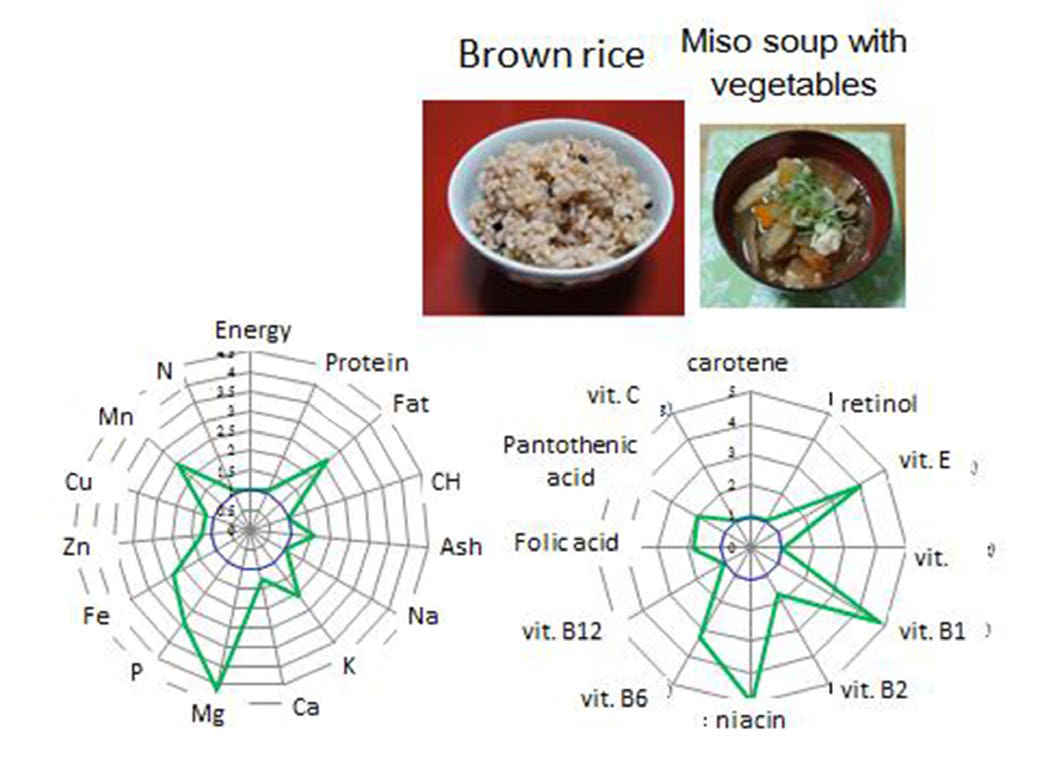
In addition to the functional effects of ingredients in brown rice, the frequency of mastication influences the brain function. In Japan, fast foods with soft texture have recently become popular for younger generation. The mastication frequency has been decreasing in proportion. The brown rice increases the chewing number of times than a meat or fish dishes.12 National Health and Nutrition Survey, Labour and Welfare (2010) showed it was only 800 times per American meal compared to the 30,000 times by genmai meal. Longer eating time acts to prevent fast eating, which would be lead to obesity, and relaxes stress.
So, brown rice could be called the “medical rice for health”. The effects of eating brown rice have been gaining attention for preventing and treating not only beri-beri and constipation, but also other chronic diseases. Organic rice can remove arsenic and other toxic chemicals ingested from fertilizers and/or insecticides.8
FUNCTIONAL INGREDIENTS IN RICE BRAN
Compared with white rice, whole brown rice, is rich in vitamins, minerals, dietary fibers and various functional chemicals (Tables 1A, 1B and 1C).9,13 About 8.52 million metric tons of brown rice are produced every year in Japan. Rice bran makes about 10% of unprocessed rice by weight, and contains 18-22% oil, of which up to 5% of unsaponifiable dark oil (Figure 2). Rice bran can be used in a variety of applications such as food, animal feed and fertilizer, but most of the rice bran is discarded at present.
Figure 2: Ingredients in rice bran.
Brown rice is produced in amounts of about 8.52 million metric tons (MT) a year in Japan. This means that 0.8 million MT of rice bran are produced annually, because rice bran makes 8 to 10% of the brown rice. Rice bran is used in a variety of applications such as food, animal feed and fertilizer, but most of the rice bran is discarded at present. Recently much attention has been paid to rice bran, because it has been reported that the ingredients of rice bran show various interesting properties, such as anti-oxidation and lowering of serum lipid levels.
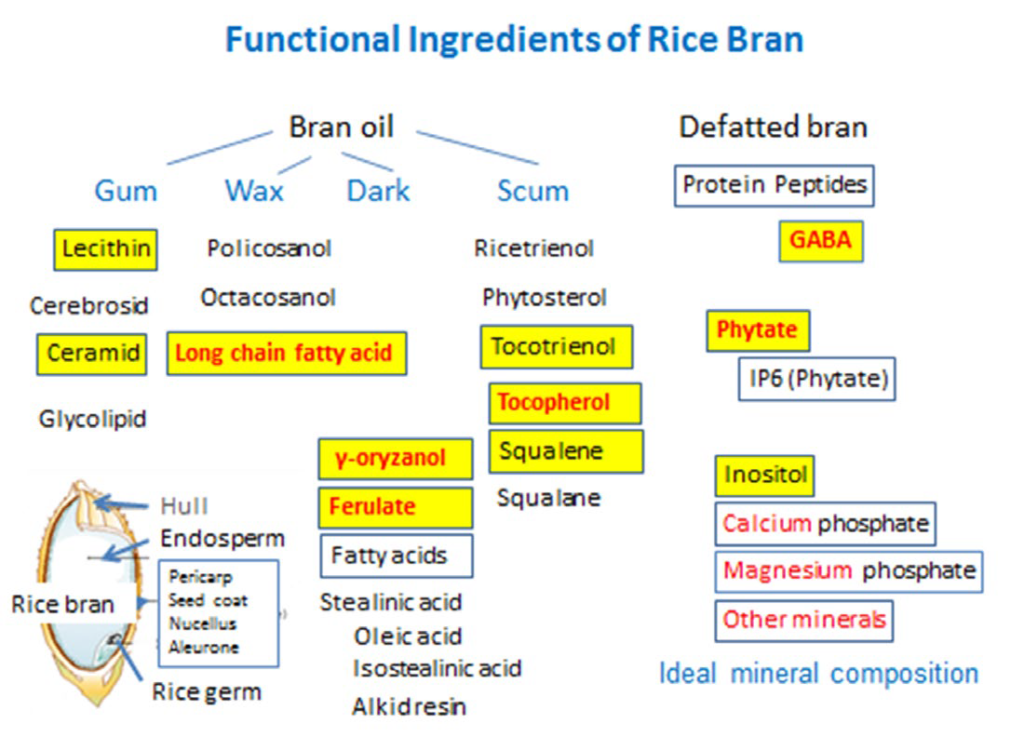
Table 1A: Nutrient composition of brown rice, milled rice and rice bran at 14% moisture content.14
| Constituent |
Rice part |
| Whole |
Polished |
Bran |
| Energy content (J) |
1520-1610 |
1460-1560 |
1670-1990 |
| Energy content (kcal) |
363-385 |
349-373 |
399-476 |
| Crude protein (g) |
7.1-8.3 |
6.3-7.1 |
11.3-14.9 |
| Crude fat (g) |
1.6-2.8 |
0.3 |
15.0-19.7 |
| Available carbohydrate (g) |
73-87 |
77-89 |
34-62 |
| Total dietary fiber (g) |
2.9-4.0 |
0.9-2.3 |
17-29 |
| Water-insoluble fiber (g) |
2.0 |
0.5 |
15-27 |
| Sugar (g) |
1.4 |
0.2-0.5 |
0.8-5.5 |
| Phytic acid (g) |
0.4-0.9 |
0.1-0.2 |
3.0-7.4 |
| Phenolic (g catechin) |
0.01-0.02 |
0.01-0.02 |
0.01-0.02 |
Table 1B: Typical minor components found in Thai rice bran oil. Thai Edible Oil Co. Ltd’s Lab, 2010-2011.
|
Minor components
|
Crude rice bran oil (%) |
Refined rice bran oil (%)
|
|
Free fatty acids
|
6-10 |
0.04-0.08
|
|
Phytosterol
|
2.9 |
1.8
|
|
gamma-oryzanol
|
1.6-1.8 |
0.2-0.8
|
|
Total tochopherol
|
0.078 |
0.062
|
|
tocopherols
|
0.021 (27.3% of tocols) |
0.020 (32.4% of tocols) |
|
tocotrienols
|
0.057 (72.6% of tocols) |
0.042 (67.6% of tocols)
|
|
Rice bran wax
|
2-3 |
0
|
Table 1C: Various nutrients and ingredients in rice per 100 g.
|
Cooked rice
|
| Major nutrients |
Major nutrients
|
Whole brown rice |
Brown rice |
Polished rice |
Pre-germinated rice
|
|
Water (g)
|
14-15
|
60-64 |
61-64 |
60-62 |
| Energy (kcal) |
353-357 |
150-204 |
145-154 |
156-160
|
|
Protein (g)
|
5.7-6.8
|
2.8-3.7 |
1.8-2.4 |
2.4-2.6 |
| Fat (g) |
3.2-3.3
|
1,2-1,7
|
0.2-0.3
|
0.8-1.0
|
|
FFA (g)
|
2.26-2.81
|
0.72-1.21 |
0.23-0.29 |
0.5-0.57 |
| SFA (g) |
0.58-0.71 |
0.2-0.3 |
0.09-0.11 |
0.16-0.17
|
|
UFA (g)
|
1.68-2.1
|
0.52-0.9 |
0.14-0.2 |
0.35-0.4 |
|
Carbohydrate (g)
|
74-76 |
32-35 |
34-35 |
34-35
|
|
maltose (g)
|
0.3
|
0.05 |
0.05 |
0.05 |
| glucose (g) |
0.2-0.3 |
0.05 |
0.05 |
0.05
|
| Dietary fiber (g) |
2.2-3.1
|
2.1-2.5 |
0.3-0.6 |
1 |
| Ash (g) |
Ash (g) |
1.1-1.3 |
0.5-0.7 |
0.1-0.2 |
0.3
|
| Minerals |
Ca mg
|
8-9
|
1.2-1.7 |
3-4 |
4-5 |
|
P mg
|
290-300 |
120-150 |
22-24 |
63-69
|
|
Fe mg
|
0.9-1
|
0.5-0.6 |
0.1 |
0.2-0.3 |
|
K mg
|
220-250 |
100-140 |
16-20 |
53-63
|
|
Mg mg
|
110-120
|
51-68 |
2-3 |
20-23 |
| Zn mg |
1.9-2.2 |
0.8-1.3 |
0.6-0.7 |
0.8-0.9
|
|
Cu mg
|
0.12-0.27
|
0.1-0.16 |
0.04-0.08 |
0.11-0.14 |
| Mn mg |
2.0-2.5 |
1.0-1.5 |
0.17-0.25 |
0.8-0.9
|
|
Se mg
|
2.5
|
2.5 |
2.5 |
2.5 |
|
Vitamins
|
vitamin B1 mg |
0.32-0.46 |
0.11-0.22 |
0 |
0.11-0.12
|
|
vitamin B2 mg
|
0.02-0.03
|
0.005-0.01 |
0.005 |
0.005 |
| vitamin B6 mg |
0.36-0.41 |
0.17-0.32 |
0.007-0.008 |
0.054-0.094
|
|
niacin mg
|
5.3-5.9
|
2.1-3.4 |
0.008-0.1 |
0.4-0.8 |
| αtocopherol mg |
1.3-1.5 |
0.6-0.8 |
0 |
0.5-0.7
|
|
βtocopherol mg
|
0.1
|
0 |
0 |
0 |
| γtocopherol mg |
0.1-0.2 |
0 |
0 |
0
|
|
θtocopherol mg
|
0
|
0 |
0 |
0 |
| protein amino acids |
Protein (g) |
5.7-6.8 |
2.8-3.7 |
1.8-2.4 |
2.4-2.6
|
|
Arg mg
|
445-534
|
201-285 |
149-194 |
185-208 |
| Lys |
228-253 |
100-137 |
65-77 |
85-93
|
|
His
|
139-164
|
92-137 |
41-53 |
53-59 |
| Phe |
269-329 |
130-175 |
95-124 |
111-125
|
|
Tyr
|
164-196
|
87-111 |
67-86 |
78-88 |
| Ala |
325-383 |
144-213 |
105-136 |
134-146
|
|
Gly
|
274-316
|
121-176 |
86-111 |
111-121 |
| Pro |
233-284 |
107-158 |
80-105 |
99-116
|
|
Glu
|
922-1130
|
413-603 |
321-423 |
400-443 |
| Ser |
297-354 |
137-198 |
104-135 |
129-141
|
|
Thr
|
220-240
|
100-148 |
171-219 |
85-93 |
| Asp |
518-611 |
236-335 |
171-219 |
213-233
|
|
Tryp
|
53-75
|
19-38 |
17-20 |
22-23 |
| Cys |
141-177 |
54-85 |
50-55 |
58-63
|
|
GABA Phytic acid
|
GABA
|
3-7
|
4-6 |
<0.5 |
3-5 |
| Phytic acid |
1.18-1.21 |
1.3-2.0 |
0.8-1.3 |
0.4-0.5
|
Recently, much attention has been paid to rice bran, because of various pharmacological properties of its ingredients, like anti-oxidation. A current study further clarified the properties of many functional ingredients in rice bran.13,14,15 A current study has further clarified the properties of many functional ingredients in rice bran15 It is separated to gum, wax, dark oil and scum by different boiling temperature for further extraction of a number of chemicals (Figure 2). The biological activities of each factor have been clarified by many in vivo and in vitro experiments. Human data by randomized clinical trials (RCT) are also accumulating.16
(1) Lipophilic Ingredients
The nutritional benefits of rice bran oil are well known.15-17 γ-oryzanol and tocotrienol are considered to be the active ingredients in the oil.18 The pharmacological effects are: a decrease in total and LDL cholesterol, an increase in high-density lipoproteins (HDL) cholesterol, a decrease in triacylglycerol and ApoB, and the inhibition of platelet aggregation. γ-oryzanol is contained in the non-saponifiable fraction of rice bran. γ-oyzanol is bound to ferulic acid, and thus belongs to the family of ferulated sterols. γ-oryzanol exists in 4 chemical forms with similar functional activities: two are triterpene alcohol esters and the other two are sterol esters (Figure 3).19,20 The solubility of γ-oryzanol is only 0.06% in water, and 0.2% in 20% ethanol. The absorption of γ-oryzanol may not be optimal after oral intake of brown rice. The proportion of γ-oryzanol is 0.1% in rice bran, but it is possible to take 300 mg of γ-oryzanol by oral intake of brown rice.
Figure 3: Gamma-oryzanol in unsaponifiable fraction of rice bran: γ-Oryzanol: Anti-stress effects, palliation of menopausal disorders and dysautonomia.
Gamma-Oryzanol being bound to a molecule known as Ferulic Acid; so it is essentially a term used to refer to a collection of ferulated sterols. Major g-oryzanol has 4 types; two are triterpene alcohol ester and the other two are sterol esters. The functional activity is not different.
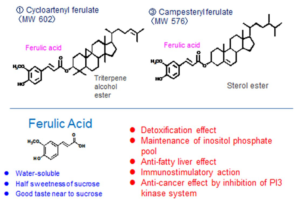
Phenolic compounds are major antioxidant and radical scavenging ingredients in rice. Nakamura et al19,20 developed a method for the simultaneous determination of phenolic compounds in rice by high-performance liquid chromatographyultraviolet (HPLC-UV). Eleven kinds of phenolic compounds were identified in rice: ferulic acid, caffeic acid, sinapinic acid, p-coumaric acid, vanillic acid, protocatechuic acid, syringic acid, hydroxybenzoic acid, chlorogenic acid, 6’-O-feruloylsucrose and 6’-O-sinapoylsucrose (Table 2). In unpolished rice, the three most abundant ones are: 6’-O-feruloylsucrose, 6’-Osinapoylsucrose, and ferulic acid.20 With their representative concentrations of 1.09, 0.42 and 0.33 mg/100 g rice flour, they represent 84.0% by weight of the total amount of soluble phenolic compounds (2.19 mg/100 g brown rice flour). Polished rice contains only 0.28 mg of phenolic compounds/100 g rice flour.
Table 2: Contents of soluble phenolic compounds in rice (mg/100 g).
|
Unpolished
|
Polished
|
|
ferulic acid
|
0.33 |
0.07
|
|
caffeic acid
|
0.02 |
0.025
|
|
sinapinic acid
|
0.02 |
0.005
|
|
p-coumaric acid
|
0.098 |
0.02
|
|
vanillic acid
|
0.072 |
0.032
|
|
protocatechuic acid
|
0.037 |
0.013
|
|
syringic acid
|
0.03 |
0.01
|
|
hydroxybenzoic acid
|
0.04 |
0.021
|
|
chlorogenic acid
|
0.033 |
0.028
|
|
6′-O-feruloylsucrose
|
1.089 |
0.026
|
|
6’-O-sinapoylsucrose
|
0.417 |
0.032
|
|
Total
|
2.186 |
0.282
|
Tocotrienol and tocopherol are lipid-soluble antioxidants, which prevent cardiovascular diseases and cancer.21 Squalene, an isoprenoid compound structurally similar to betacarotene, is an intermediate metabolite in the synthesis of cholesterol. In humans, about 60 percent of dietary squalene is absorbed.
(2) Water-Soluble Ingredients
Inositol and phytic acid are water-soluble ingredients like GABA.22-28 Magnesium, calcium and other trace elements are also included in this fraction.
In 2008, Maeba et al26 reported an interesting clinical observation about the preventive effect of inositol on metabolic syndrome. Seventeen subjects with metabolic syndrome were given inositol per os for 2 weeks (5 g a day for one week and 10 g a day thereafter). The authors observed a significant decrease in total cholesterol, LDL cholesterol, small dense LDL cholesterol and apolipoprotein B (a marker of post-prandial hyperlipidemia). Waist circumference, high-sensitivity CRP and fasting blood glucose level also improved. Interestingly, a significant decrease in blood glucose level was only observed among subjects with metabolic syndrome. This may reflect higher concentrations of serum plasminogen, which is a protective factor against oxidative stress. The finding suggests that plasmalogen is a key factor mediating the beneficial effect of inositol on the metabolic syndrome.
Myoinositol is a ring-shaped polyalcohol (Figure 4). It has half the sweetness of sucrose. It is an element of the vitamin B complex, although it is not a real vitamin. It is present in human colostrum, and considered to be essential for babies’ growth. It is also effective for the prevention of metabolic syndrome. It has shown anti-fatty liver effect, anti-diabetic effect, improvement of metabolic syndrome, effectiveness against panic disorders and obsessive-compulsive disorders, and inhibitory effect on lung cancer in animal experiment.27 The intake of large amounts of inositol (more than 10 g a day) could improve the panic syndrome.28
Figure 4: Inositol and phytic acid.
Inositol and phytic acid are water soluble ingredients like GABA. for mental health. Magnesium, calcium and other trace elements are also present in the same fraction. Inositol is a member of vitamin B complex, although it is not a real vitamin. It is rich in human colostrum, and considered to be essential for baby’s growth. It has anti-fatty liver effect, anti-diabetic effect, improvement of metabolic syndrome, effectiveness for panic disorder and obsessive-compulsive disorder. Intake of large amount of inositol, more than 10 g a day, could improve the panic syndrome.
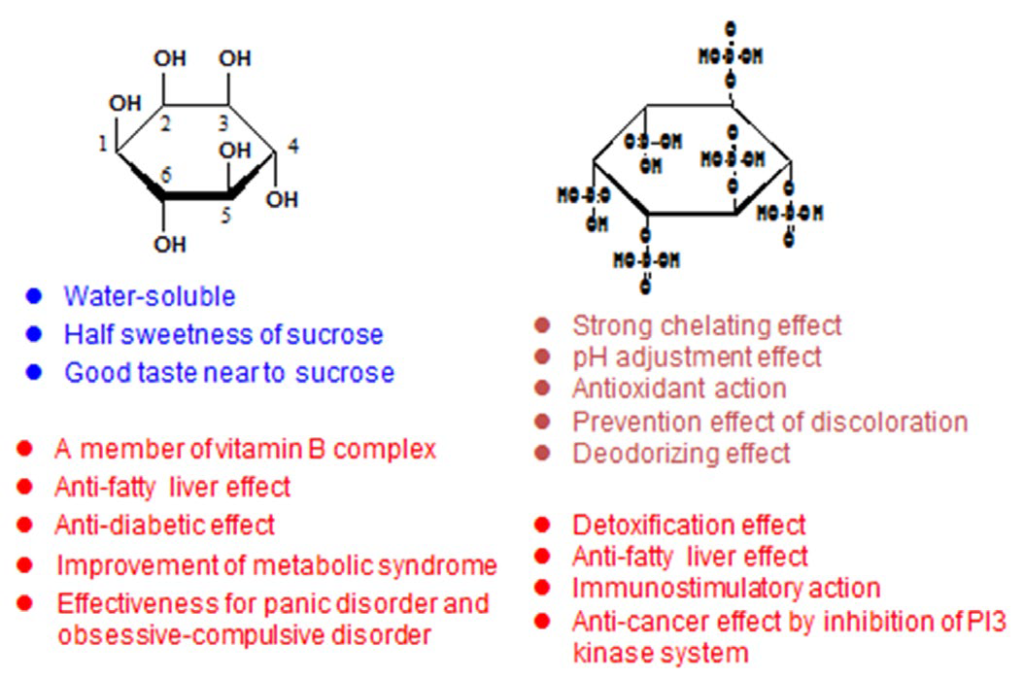
Phytic acid is a phosphatized inositol, and has a strong chelating effect, pH adjustment effect, and antioxidant action. It is used for the prevention of discoloration and as a deodorant. In vivo, it is expected to have various effects, for example: detoxification, anti-fatty liver effect, immuno-stimulatory action, and anti-cancer effect by inhibition of the phosphoinositide (PI) 3-kinase system.
CONCEPT OF MEDICAL RICE
Many different kinds of rice have been developed in Japan and other rice producing countries.9,29 Some varieties are expected to prevent various diseases, or to be used for dietary therapy.30 For example, ‘super-hard’ high-amylose rice could be used for diabetic patients,31 low-protein or low-gluterin rice for patients with renal failure,32,33 GABA-rich large germ rice is expected to improve mental health,34 and rice with high antioxidant properties would be effective for the prevention of cancer and other diseases.35,36 Human data are accumulating, so we believe it is time to introduce the concept of medical rice for disease prevention and treatment (Table 3).
Table 3: Candidates of medical rice.
| Medical rice for health |
Organic brown rice containing nutrients and functional ingredients |
| Medical rice for diabetes |
Superhard rice or rice powder with low GI, mostly less than 50 |
| Medical rice for kidney disease |
Low protein rice containing less than 1/25 protein |
| Medical rice for mental health |
High GABA, and/or γ-oryzanol/ferulic acids |
| Medical rice for cancer prevention |
Brown rice with high antioxidant activity with functional ingredients |
(1) Medical Rice for Diabetes
In 2012, a meta-analysis reported an association between white rice intake and increased risk of type-2 diabetes (T2D), suggesting the need to replace white rice by brown rice in the Japanese diet.37 The effects of brown rice on visceral obesity and endothelial function were shown in the Okinawa branch retinal vein occlusion (BRAVO) study.38 Participants were between 30 and 60-years-old males with metabolic syndrome. Brown rice reduced their post-prandial blood glucose level and insulin level. A decrease in body weight and an improvement of various biochemical abnormalities were also observed. The benefit of brown rice and brown rice with legumes for glycemic and insulinemic control were also shown by Mulan et al.30
Recently, Ohtsubo et al39,40,41 succeeded in harvesting special super-hard rice, which contained a high concentration of resistant starch, due to long amylopectin chains. It showed good effect on postprandial glucose level and insulin secretion (Figure 5). However, the taste is different from ordinary Japonica rice. So, they next developed super-hard-rice powder after boiling. Now, the powder of super-hard rice is available for a number of new food items. For example, medical “Tomato Bread” is made of super-hard rice powder, containing resistant starch, GABA rich pre-germinated brown rice, tomato as a source of lycopene, and gelatinized rice flour for durable palatability. The size and taste is comparable to wheat bread. Tasty rice noodle is also made from this powder.31,40
Figure 5: Postprandial blood glucose and insulin level.
Super hard rice showed suppression of postprandial glucose level and insulin secretion. Super hard rice or purple rice, and new technology, such as co-extrusion with red onion germination, make it possible to fortify bio-active rice bread.
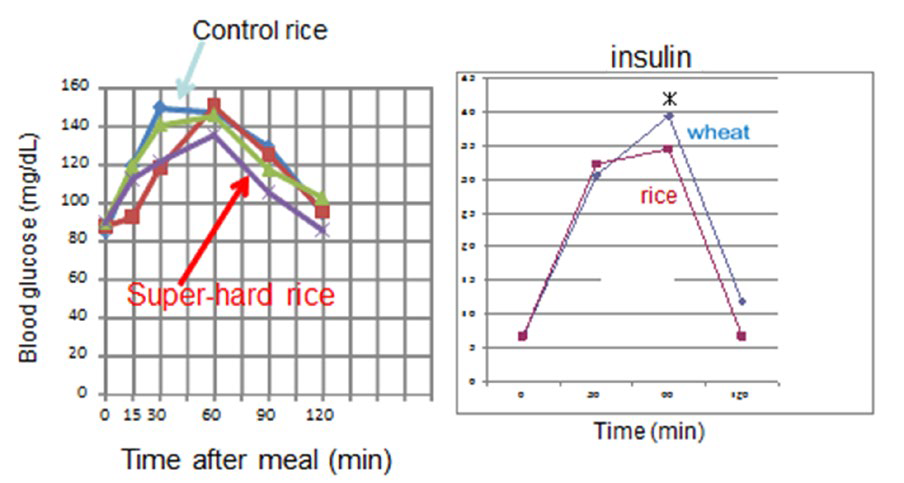
Figure 6: (a) Aseptic Package of low protein rice and (b) nutritional components of low protein rice
A: Low protein rice.
Low protein rice is available in packed state in Japan. There are five different amount of protein rice. The rice content is 150 g to 180 g to fulfill 160 kcal (2 serving unit of Diabetic Society). Lowest protein concentration is 0.1 g, which is 1/25 of normal rice. Palatability period is usually 7 months, but some has 3.5 year best-before period as storage pack for a disaster.

B: Low protein rice.
Nutritional aspect of low protein rice is characteristic. Energy source is preserved and protein concentration is well controlled. Low potassium and phosphate concentration are additional benefits for CKD patients. If the patients continue to eat meat, the control of K and P is very difficult.
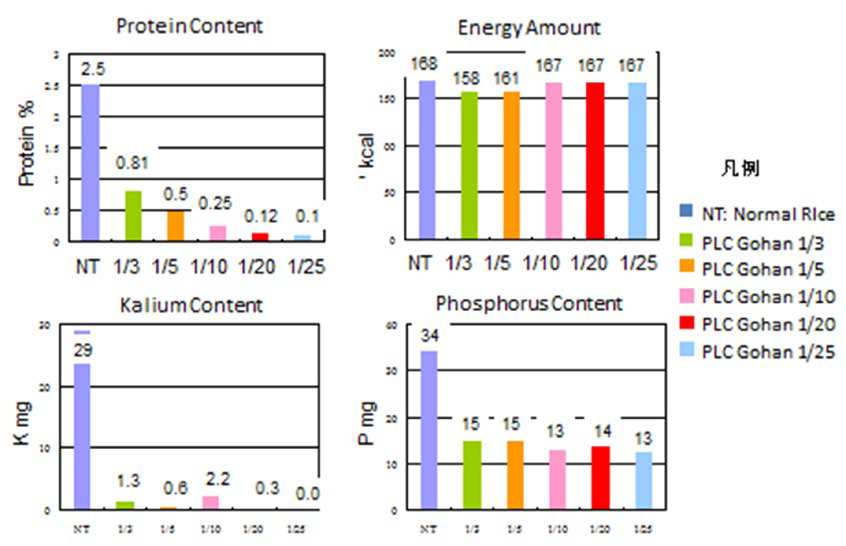
(2) Medical Rice for Chronic Kidney Diseases (CKD) and Renal Dysfunction.
One of the benefits of a low-protein diet is the preservation of the kidney function.42 Distinct mechanisms could be identified: (1) improvement of hyperphosphatemia and hyperkalemia, (2) decrease in urinary protein, (3) improvement of subjective symptoms, (4) prevention of complication, (5) good control even after indication of hemodialysis for better survival.43
The protein in rice is stored in two different types of compartment.44 The major proteins are prolamin and gluterin. Prolamin is the alcohol soluble protein fraction remaining after salt extraction of globulin. Glutelin is the dilute-acid or dilutealkaline soluble protein fraction after prolamin extraction. Most of the prolamin was present at the periphery in whole rice grains, implying that prolamin is removed by enzymatic digestion on polished white rice.33
Low-protein rice is available in Japan in five different packages, depending on their different amount of protein. The rice content varies between 150 g and 180 g to reach a total content of 160 kcal (2 E-unit).45 The lowest protein concentration is 0.1 g/pack, which is 1/25 of normal rice (Figures 6A and 6B). The palatability period is usually 7 months, but some packages have an extended storage period of 3.5 years for disaster situations.
Ideura46 confirmed the effects of a low-protein diet on patients with chronic kidney diseases. At the threshold of renal failure of 6 mg serum creatinine/dl, low protein diet had started. With a content of 0.4-0.5 g/kg body weight, the median survival was 4 years.
With a content of 0.6 and 0.7 g/kg, no beneficial effect was observed compared with a control group (>0.8 g/kg body weight). The optimal low-protein content was 0.3 g/kg body weight. Low potasium and phosphate concentrations are additional benefits for CKD patients.
Sun et al47 performed a preliminary study in Huadong Hospital (Shanghai, China), examining the effect of 12-weeks of low-protein rice as dietary therapy (0.6 g/kg body weight) for CKD patients. Cooked rice was provided 3 packs/day containing 1.35 g proteins and 900 kcal energy.33 The meal plan was checked by trained research dietitians, and dietary intake and compliance were monitored through diet diaries.
Compared with baseline levels, the total dietary energy increased from 1606 kcal/d (27.9 kcal/kg bwt) to 1748 kcal (30.8 kcal/kg bwt). Dietary daily vitamin B1 intake increased from 0.34 mg to 0.78 mg, and vitamin B2 intake from 0.42 mg to 1.08 mg. Serum albumin slightly increased from 44 g/L to 46 g/L. The total serum protein concentration increased from 74 g/L to 77 g/L. Meanwhile, changes in body weight, BMI, and hemoglobin were not significant. After 12 weeks, urinary protein levels decreased from 0.4 g/d to 0.1 g/d. Urine albumin decreased from 130.8 mg/24 h to 60.8 mg/day. Twenty-four urinary protein, albumin excretion, and urinary albumin/creatinine ratio decreased by 63.7%, 55.0% and 52.0%, respectively.
Low-protein rice was well accepted by Chinese CKD patients. It is an important tool for CKD dietary therapy as it increases energy and micronutrients intake and improves the nutritional status. A long-term and large sample size RCT study is planned in Thailand to confirm the protective effects of lowprotein rice on CKD progression.
The average Japanese citizen consumes 60 g protein a day, and half comes from rice. By using low-protein rice, we can reduce the protein intake by half. The amount of fish or chicken on side dishes does not need to be strictly restricted. However, if the main dish contains a large portion of beef like in the American diet, meat is the source of both protein and energy. In the well-designed multicenter Modification of Diet in Renal Disease (MDRD) study,48 the benefit of a very low protein diet could not been shown. We analyzed their data and found the reason why MDRD study was failed.49 The energy intake was less than 70% of the protocol, probably due to the cut of meat from main dish. So, energy deficiency could plausibly have worsened the disease.49
Medical rice for CKD should contain enough energy source and low protein, as well as low potasium and phosphate.
(3) Medical Rice for Mental Health
As the society is aging, the number of people with impaired cognitive function becomes serious problem in the world. In Japan the number of people with dementia is estimated to be 2 million, and World Health Organization (WHO) estimates that 47.5 million people have dementia, with 7.7 million new cases every year worldwide.50
Large-germ brown rice and pre-germinated brown rice contain functional ingredients to prevent dementia, such as GABA, γ-oryzanol, in addition to nutritional elements such as vitamins, minerals, and dietary fibers.51,52 GABA and γ-oryzanol are involved in the metabolism of hypothalamic catecholamines.
γ-Oryzanol is known to have anti-stress effects, to palliate menopausal disorders and dysautonomia. Other effects have recently been reported , for example: improvement of hypertension, curative effect of Alzheimer’s disease, amelioration in muscular fatigue.53,54 Antioxidant effect, radical eliminating action, ultraviolet absorptive action, anti-inflammatory effect, antidiabetic effect, anti-allergic effect, increase of insulin like growth factor 1 (IGF-1) and antibacterial action are also reported, but the main hope is an improvement of cognitive function.52
GABA is also a candidate for mental health. Largegerm rice and pre-germinated brown rice (GBR) contain a high amount of GABA.54 Pre-germinated brown rice was developed for easy cooking, keeping the many nutritional and functional ingredients, such as dietary fiber, vitamins and minerals, GABA, γ-oryzanol, acyl-sterol glycoside, etc. GBR contained not only GABA, but also ferulic acid.
The effect of ferulic acid mixed with Angelica archangelica extract on cognitive functions and behavioral and psychological symptoms of dementia have been examined by Kimura et al52 (Figure 7) and many symptoms were shown to improve (Table 4).
Table 4: Changes in neuropsychiatric inventory score.
4 weeks after Feru-guard® treatment in 20 patients with frontotemporal lobar degeneration or dementia with Lewy bodies.
|
Baseline
|
Follow-up |
p value*
|
| NPI total score |
28.3±9.6
|
17.7±9.7 |
<0.001
|
| Delusions |
2.2±2.7
|
1.3±2.1 |
<0.05
|
| Hallucinations |
2.8±3.4
|
1.1±2.1 |
<0.02
|
| Agitation/aggression |
4.6±3.2
|
2.5±1.9 |
<0.001
|
| Depression/dysphoria |
1.7±2.9
|
1.2±2.0 |
NS
|
| Anxiety |
1.9±2.3
|
1.5±2.0 |
<0.04
|
| Euphoria |
0.2±0.9
|
0.2±0.9 |
NS
|
| Apathy/indifference |
5.9±2.4
|
3.3±1.9 |
<0.001
|
| Disinhibition |
1.9±3.1
|
1.8±2.9 |
NS
|
| Irritability/lability |
4.0±3.2
|
2.3±2.0 |
<0.005
|
| Aberrant behavior |
3.4
|
2.6 |
<0.05
|
Figure 7: Mental health: Control of behavioral and psychological symptoms of dementia (BPSD).
Treatment with ferulic acid extract led to reduced NPI scores in 19 (95.0%) out of 20 patients and to significantly decreased NPI scoresoverall (p<0.001).55
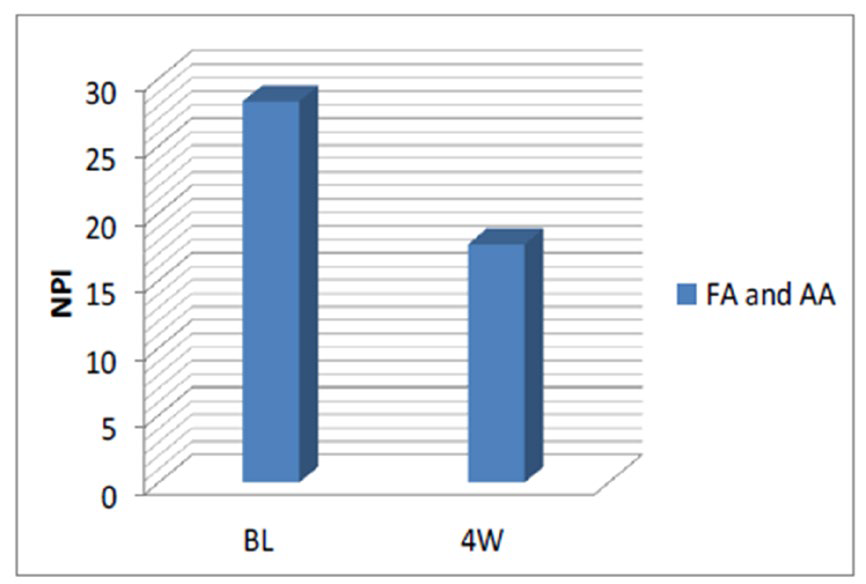
Pregnant women often become unstable in mood. In an intervention study, 41 pregnant women were randomized to take germinated rice or white rice for 14 days.54 A psychological test profile of mood states (POMS) was done before and after the study, and salivary amylase was measured as a stress marker. POMS test measures 6 dimensions of mood, and depression, anger-hostility, fatigue score significantly improved by brown rice eating, and total mood disorders (TMD) was nearly half of that of white rice (Figure 8)
Figure 8: Mother’s stress measured by POMS: Changes in POMS scores before and after dietary intervention by GABA rich rice.
Pregnant women often becomes unstable in mood. Is this intervention study, 41 pregnant women were randomized to take germinated rice or white rice for 14 days. As the psycological test, POMS test was done before and after the study, and salivary amylase was measured as a stress marker. POMS test measures the 6 axises of mood, such as tensionanxiety, depression, anger-hostility, vigor, fatigue, and confusion. High score of all six, except for vigor, suggests the unfavorable mood, and high score of vigor suggests favorable mood. Higher TMD score (Total Mood Disturbance) suggests in bad mood.56
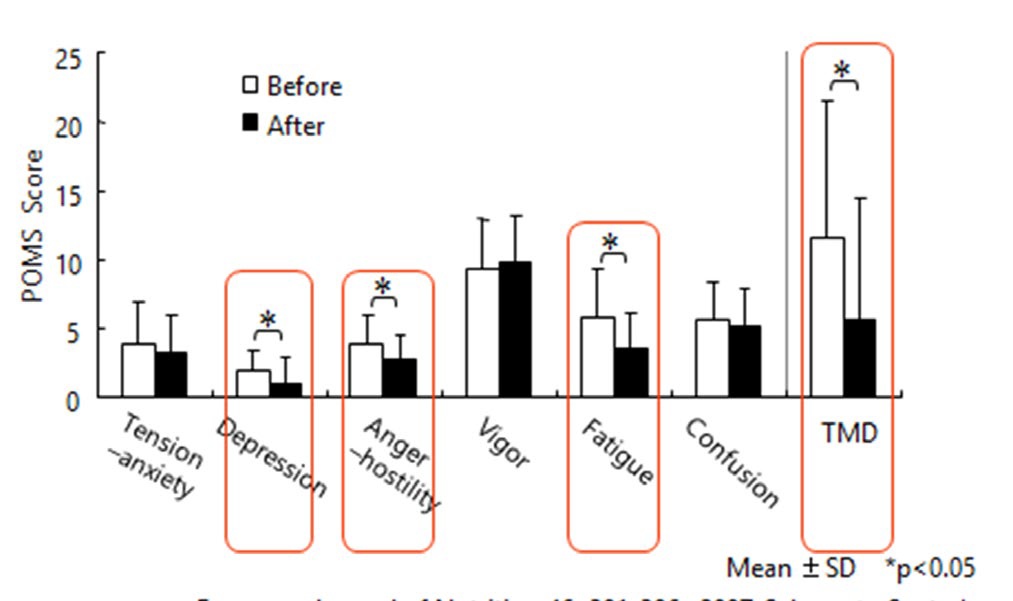
Mothers who in took pre-germinated rice is shown by black column and those who ate white rice is shown by white column. Depression, anger-hostility, fatigure score significantly improved by brown rice eating, and TMD was nearly half of that of white rice.
In addition to their mental effects, the giant-germ rice and GBR are also useful for diabetic and hypertensive patients. In a randomized-controlled trial comparing two packs of GBR rice with white rice, 24 healthy volunteers (10 males and 14 females, aged from 27 to 47) were studied for the effect on blood pressure. The GBR group displayed a significant reduction in systolic blood pressure after 12 h of GBR intake, particularly marked after 6 minutes of physical load with an ergometer. It was also shown that the blood glucose levels and the incremental area under the curve (IAUC) were lower after taking GBR. The IAUC was 1448 mg/min/dl in GABA rich group, whereas it was 1601 mg.min/dl in white rice group.
These results demonstrate that this special pre-germinated brown rice (GABA+ferulic acid) may be effective in subjects with mild hypertension and diabetes mellitus, in addition to the mental health.
Other components of rice bran (steryl glucosides [PSG] for example) were found to be effective for coping against stress. So, medical rice for mental health is at least defined to contain high GABA and γ-Oryzanol or ferulic acid.57
(4) Medical Rice for Cancer Prevention
In various animal experiments, Muto et al58,59,60 showed that fermented rice bran (FBRA) strongly prevented the incidence of colon, breast, head and neck, esophageal, and pancreatic cancers almost half. The antioxidant activity of rice bran could be considered to be a major factor.
The effects of many phytonutrients are expected to work well beyond free radical protection. Of late, an antioxidant test known as Oxidation Radical Absorbance Capacity (ORAC) has become popular61,62,63 Other similar assays, such as DPPH, TRAP, TEAC etc. are available to specify the antioxidant capacity of food ingredients.
This is why consumers are often confused by different values as there is no readily available comparison method among the values obtained by different assay systems. It is proposed that the antioxidant capacity of complex supplements should be expressed in terms of standardized antioxidant units (AOU), pondering the antioxidant values obtained in aforementioned assay system.64 Japanese intake of AOU per day is estimated more than 10000 AOU unit throughout a year.65
Beyond the standard antioxidant vitamins, such as vitamin C and E, we should consider antioxidants found in brightly pigmented whole fruits and vegetables, mostly due to anthocyanins and proanthocyanins.64 We measured antioxidant activities of various rice varieties, and found that only brown rice showed antioxidant activity (Table 5). Black rice showed the highest anti-oxidant activity. Both brown rice and black rice retained the high anti-oxidant activity even after cooking.66 Polished rice did not show antioxidant activity at all. The presence of antioxidant activity in daily meals should prevent carcinogenesis and diseases caused by free radicals.
Table 5: Antioxidantactivity of various rice and cooked rice.
These rice with high antioxidant activity could be categorized in the medical rice for cancer prevention.
AOU-F: Antioxidant unit by flavonoids; AOU-C: Antioxidant unit like carotenoids.
|
ORAC_W (AOU P)
|
ORAC_L (AOU C) |
Total
|
| Raw brown rice |
13
|
4 |
17
|
| Raw brown rice |
15
|
4 |
19
|
| Raw brown rice |
11
|
5 |
16
|
| Cooked brown rice by pressure pan |
5
|
3 |
8
|
| Cooked brown rice by pressure pan |
6
|
1 |
7
|
| Cooked brown rice by pressure pan |
6
|
1 |
7
|
| Cooked brown rice without pressure |
6
|
1 |
7
|
| Cooked brown rice without pressure |
5
|
1 |
6
|
| Cooked brown rice without pressure |
7
|
2 |
9
|
| Pregerminated rice |
1
|
<0.5 |
1.5
|
| Pregerminated rice |
2
|
<0.5 |
2.5
|
| Cooked polished rice “kinme” |
<0.5
|
<0.5 |
<0.5
|
| Cooked polished rice “kinme” |
<0.5
|
<0.5 |
<0.5
|
| Cooked polished rice “kinme” |
<0.5
|
<0.5 |
<0.5
|
| cooked polished white rice |
<0.5
|
<0.5 |
<0.5
|
| cooked polished white rice |
<0.5
|
<0.5 |
<0.5
|
| cooked polished white rice |
<0.5
|
<0.5 |
<0.5
|
This rice is organic brown rice, containing enough vitamins and minerals with high antioxidant ability, without any detectable herbicide or toxic heavy metals.
CONCLUSION
The health effects of brown rice are empirically well known, and accumulating evidence about the physiological and pharmacological activity of rice bran strongly supports the use of brown rice in meals, although this is not popular in Japan and other countries. However, in response to the enormous increase of medical costs, the Japanese government starts to encourage healthy longevity measures by changes of dietary habits. Functional food labeling has started in 2015, so the proper food labeling of medical rice could help people who want to control and/ or improve their health status.44 An example of food label for ‘Medical Rice for Health’ is shown in the figure (Figure 9).
A word in the lower part of the mark could be changed according to the purpose.
Figure 9: Food labeling of medical rice and licensed medical rice for health.
This rice is organic brown rice, containing enough vitamins and minerals with high antioxidant ability, without any detectable herbicide or toxic heavy metals.
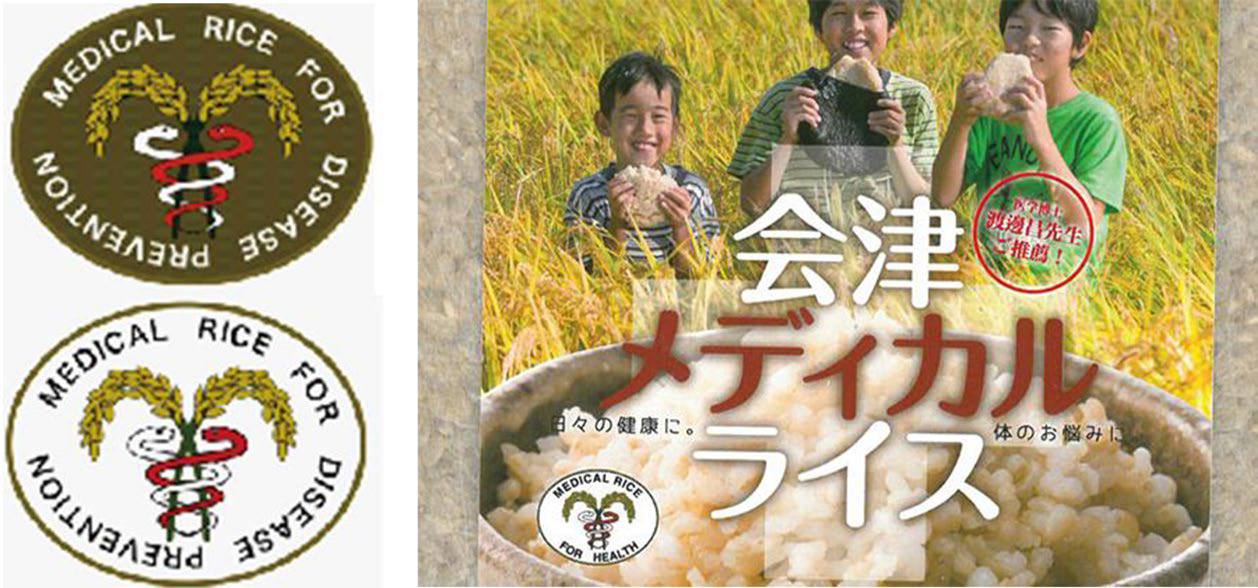
ACKNOWLEDGEMENTS
The authors deeply appreciate the participants in the East Asia Conference of Standardization of Rice Function, which was held in Kyoto from December 10 to 12, 2014. All authors attended the conference and contributed to make the entity of medical rice, providing their original data.
The authors also thank the financial support of Human Health Foundation, Toyo Rice Cooperation, Tsuno Rice Fine Chemicals Co, Ltd. Fancl Cooperation, Genmai-koso Co. Ltd, and Forica Food Co. Ltd. to open this conference. A part of this work was presented at the 9th Asia Pacific Conference on Clinical Nutrition, which was held in Kuala Lumpur, Malaysia in 2015. They also thank to Dr. Philippe Calain for his contribution to complete this manuscript.
CONFLICTS OF INTEREST
The authors do not have any conflicts of interest regarding this paper to any company.















